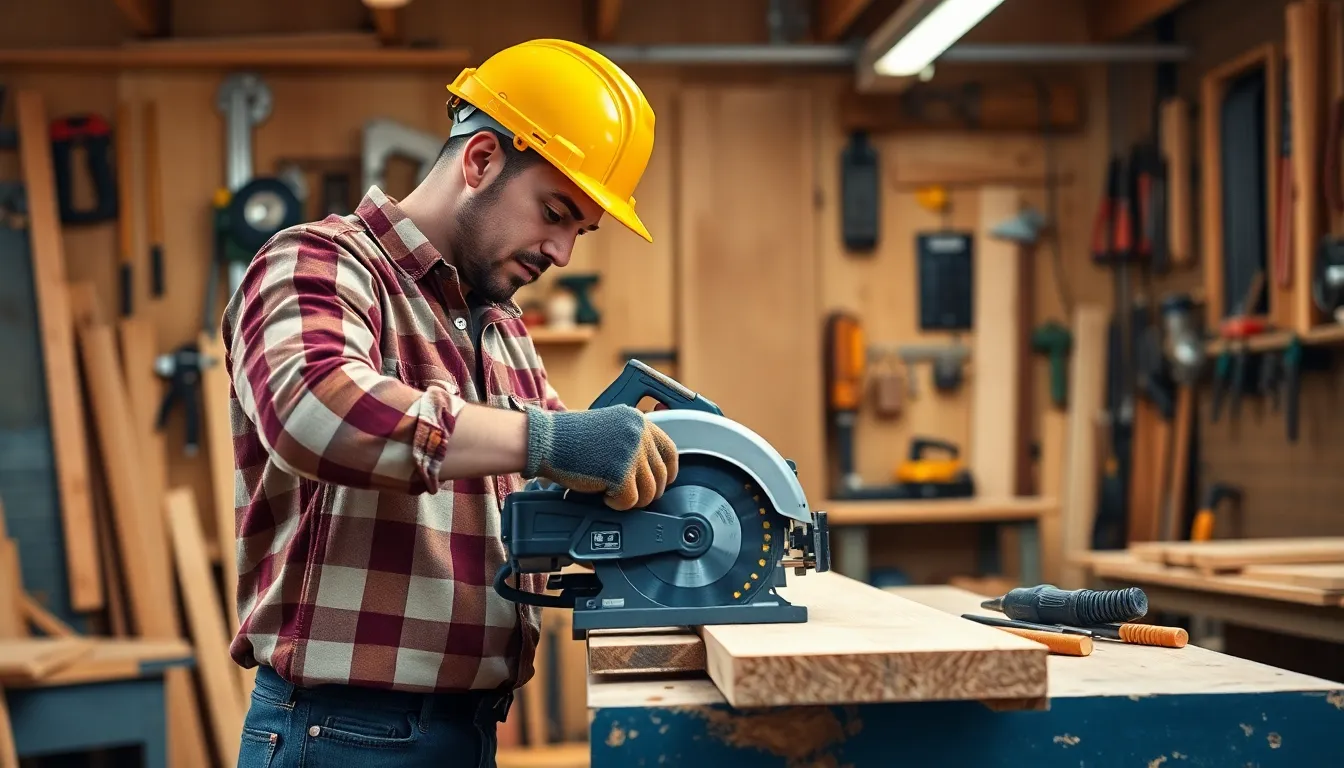Table of Contents
ToggleEvery carpenter knows the right tools can make or break a project. Whether it’s shaping a piece of wood or crafting a masterpiece, having the right arsenal is crucial. Imagine trying to build a treehouse with nothing but a butter knife—it’s a recipe for disaster and a very disappointed kid.
From chisels that slice through wood like butter to saws that can make the cleanest cuts, each tool plays a vital role in the carpenter’s toolkit. Understanding these tools not only boosts efficiency but also transforms a novice into a woodworking wizard. So, if you’re ready to swap your butter knife for something a bit more powerful, let’s dive into the fascinating world of carpenter tools and discover what makes them essential for any woodworking enthusiast.
Overview Of Carpenter Tools
Carpenter tools play a crucial role in the woodworking process. Essential tools include saws, which help cut wood with precision, and chisels, designed for shaping and carving. Understanding the function of each tool enhances productivity and craftsmanship.
Measuring tools deserve special attention as they ensure accuracy in every project. Tape measures enable quick length assessments while squares assist in creating right angles. Both tools contribute to achieving high-quality results.
Power tools also significantly increase efficiency in carpentry. Circular saws and jigsaws streamline cutting processes, allowing for complex shapes. Drills facilitate fast and easy fastening, making assembly simple.
Hand tools remain indispensable despite the growth of power tools. Hammers, for instance, deliver significant force for driving nails, while screwdrivers provide manual control during assembly. Each tool has its unique advantages and use cases.
Woodworking enthusiasts benefit from having a well-rounded toolkit. Selecting high-quality tools leads to improved results, making projects more enjoyable. Proper maintenance of these tools ensures longevity and reliability over time.
In addition to the standard tools, specialized equipment may also enhance woodworking endeavors. Router tools create detailed edges and grooves, while planers ensure surface smoothness. Such tools elevate the quality of the finished product, attracting both hobbyists and professionals alike.
Essential Carpenter Tools

Carpentry relies heavily on a variety of tools that enhance both efficiency and quality. Knowing which tools to use can make a significant difference in any woodworking project.
Hand Tools
Hand tools form the backbone of carpentry. A hammer drives nails with precision, ensuring solid joints. Chisels allow for intricate detailing, helping craftsmen shape wood accurately. Squares maintain right angles for more complex cuts, while levels ensure surfaces are even. Tape measures provide essential measurements for dimensions, guaranteeing a perfect fit. These tools exemplify the traditional methods that have stood the test of time, proving indispensable for many tasks.
Power Tools
Power tools revolutionize carpentry with speed and efficiency. Circular saws make straight cuts in wood much quicker than manual saws, increasing productivity on larger jobs. Drills effortlessly create holes for screws and dowels, streamlining assembly tasks. Saws like reciprocating and jigsaws allow for intricate cuts, expanding design possibilities. Routers shape edges and add details, enhancing both aesthetics and functionality. Utilizing these tools elevates the craftsmanship, particularly for those tackling extensive projects or working with thick materials.
Specialty Carpenter Tools
Specialty carpenter tools enhance the precision and quality of woodworking projects. Various tools fall within this category, serving unique functions.
Measuring Tools
Measuring tools play a crucial role in carpentry. Accurate dimensions underpin every successful project. Tape measures, calipers, and squares provide necessary precision. Tape measures extend to various lengths, accommodating different project sizes. Calipers aid in measuring small gaps and details, ensuring fit and finish. Squares assist in confirming right angles for structural integrity. Choosing high-quality measuring tools increases reliability, promoting better craftsmanship.
Cutting Tools
Cutting tools are essential for shaping wood accurately. Saws, chisels, and dedicated cutters each serve specific purposes in the woodworking process. Handsaws allow for intricate cuts, while jigsaws handle curves with ease. Circular saws streamline large cuts, vastly improving efficiency with quick execution. Chisels excel at fine detailing, enabling precise mortises and joints. Evaluating the project’s requirements determines which cutting tools best suit the task, leading to successful outcomes.
Maintenance Of Carpenter Tools
Regular maintenance ensures the longevity and effectiveness of carpenter tools. Keeping tools clean and properly stored prevents rust and damage. Sharp blades and edges maintain precision during use, so regular sharpening is essential.
Cleaning tools after each use helps prevent buildup of dust and debris. Use a damp cloth for wooden handles and a wire brush for metal parts. Additionally, inspect tools for wear and tear; replace worn components promptly.
Applying oil to blades and moving parts reduces friction. Use machine oil on metal surfaces to prevent rusting and corrosion. Protect wooden handles by occasionally applying wax or a wood conditioner.
Storing tools in a dedicated space prevents damage and loss. A toolbox or wall-mounted pegboard keeps everything organized and accessible. Ensure power tools are unplugged and stored in a dry area to prevent moisture damage.
Conducting regular safety checks allows early detection of any potential issues. Check for loose screws, frayed cords, or other defects before using power tools. Safety should always come first, so prioritize tool maintenance to enhance overall safety.
Documenting maintenance records helps track usage and service history. Include dates and types of maintenance performed for future reference. This practice aids in identifying patterns and determining when a tool requires replacement.
Maintaining carpenter tools supports smoother operation and improves craftsmanship. Adhering to maintenance routines fosters an efficient and productive woodworking environment.
Having the right carpenter tools is crucial for achieving successful woodworking projects. Each tool serves a specific purpose and enhances both efficiency and precision. From hand tools that allow for intricate detailing to power tools that speed up processes, a well-rounded toolkit is essential for any woodworker.
Regular maintenance of these tools ensures they perform at their best and last longer. By prioritizing quality and proper care, woodworking enthusiasts can elevate their craft and enjoy a more fulfilling experience. Embracing the right tools and maintenance practices can lead to impressive results in every project undertaken.





